
【鑑賞レポート】2024年第60回ヴェネチア・ビエンナーレ ~ 英語が読めなくても「タイパ良く」見る方法 ~【Viewing Report】 The 60th Venice Biennale 2024 ~ How to view efficiently even if you can't read English ~
■ 2024年4月20日から11月24日まで開催されている第60回ヴェネチア・ビエンナーレに行ってきました。
英語があまりできず、海外旅行初心者、海外芸術祭初体験の身ですが、多少の参考になればと思います。下記が公式サイトですが、開幕から間もない4月下旬に行ったので、出発前に得られた日本語情報は多くはなく、知らない美術家がほとんどでしたし、予習はあまりできず不安の中での出発となりました。
■ I went to the 60th Venice Biennale.
I'm not very good at English, I'm new to traveling abroad, and this is my first experience at an overseas art festival, but I hope this will be of some help.
Since I went in late April, not long after the opening, I didn't have much information on the Japanese language before I left, and I didn't know most of the artists, so I didn't have much preparation, so I left with some anxiety.
■ ポイント① まず、ガイドブックを買おう!
現地丸2日で見る行程で行きました——月曜日が休館。9/30までは11時から19時までオープン。4月下旬のヴェネチアの日没は20時ごろ。チェックインしたホテルで頂いたヴェネチアの一般的な地図とGoogleマップを頼りにまず、ジャルディーニ会場に急ぎました(サン・マルコ広場から徒歩約25分)。
ジャルディーニの中央パビリオンの売店で売っていた公式カタログは高価(90€)でかなり分厚く重いのであきらめ、少し厚め(約500ページ)のガイドブック(20€)を購入しました。このショートガイドブックの情報は公式サイトでも同じものを得られますし、各国パビリオン等の冒頭の掲示説明も基本的には情報は同じです。でも、何より「紙」が便利だと思われる方は、まずこのガイドブックを購入されることをおススメします。
■ Point ①: First, buy a short guidebook!
I went there on a two-day itinerary ― it was closed on Mondays. Open from 11:00 to 19:00 until 9/30.Sunset in Venice in late April is around 8pm.
Relying on Google Maps and the typical map of Venice that I received at the hotel I checked into, I hurried to the Giardini venue ― about 25 minutes walk from SAN MARCO.
The official catalog sold at the shop in the central pavilion of the Giardini was expensive (90€) and quite thick and heavy, so I gave up and bought a somewhat thicker (about 500 pages) short guidebook (20€).
The same information in this short guidebook can be found on the official website, and the information posted at the beginning of each country's pavilions is basically the same.
However, if you think "paper" is more convenient than anything else, we recommend purchasing this short guidebook first.
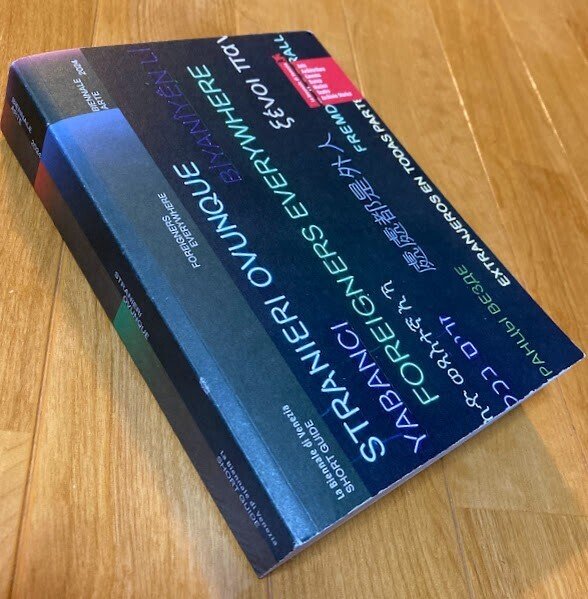
■ ポイント② ジャルディーニとアルセナーレの主要2会場では、ドイツ館とオールトラリア館がおススメ!
ジャルディーニ会場ではまずはドイツ館。ARTnewsJAPAN等の速報で評価されていたとおりでしたが、キャプションなどの英語情報が読めない者にとっても感覚的に体感できる作品でした。展示室内にはパフォーマーがおり、演劇的な作品となっています。何かドイツの昨今の世情を感じる不穏な雰囲気の作品でした。なお、パビリオン内の個別展示室入口前には若干の待ち行列ができていました——待ちは5分ぐらい。
■ Point ②: At the two main venues, Giardini and Arsenale, I recommend the German Pavilion and the Australia Pavilion!
At the Giardini venue, first is the German Pavilion. It was as evaluated in breaking news such as ARTnewsJAPAN etc., but it was a work that even those who could not read English information such as captions could experience it intuitively.
There are performers in the exhibition room, making it a theatrical work.
It was a work with a disturbing atmosphere that felt like something about the current state of affairs in Germany. In addition, there was a small queue in front of the entrance to the individual exhibition rooms in the German Pavilion ― the wait was about 5 minutes.
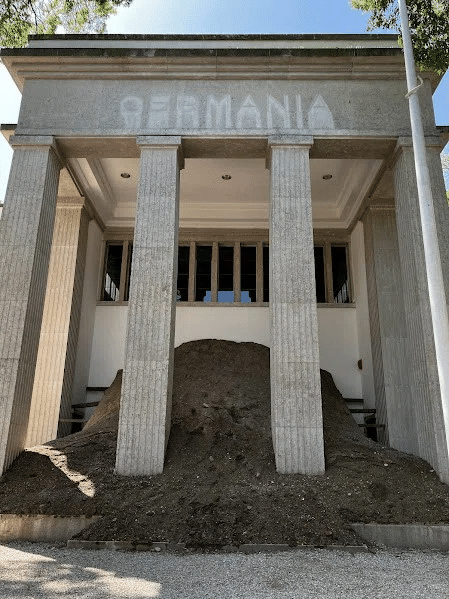
……「GERMANIA」の文字盤は、Hans Haackeが1993年に取り外したままになっているのかも?

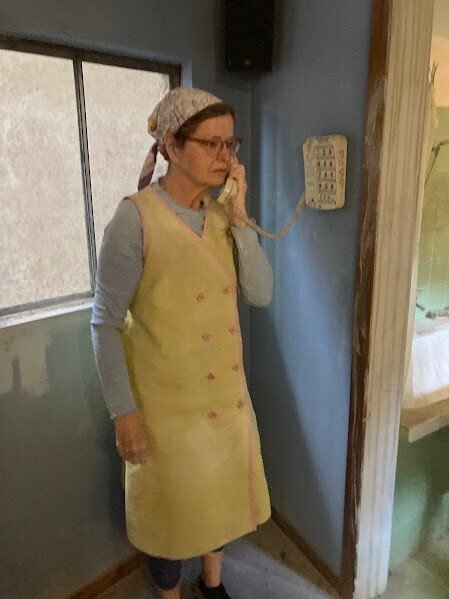
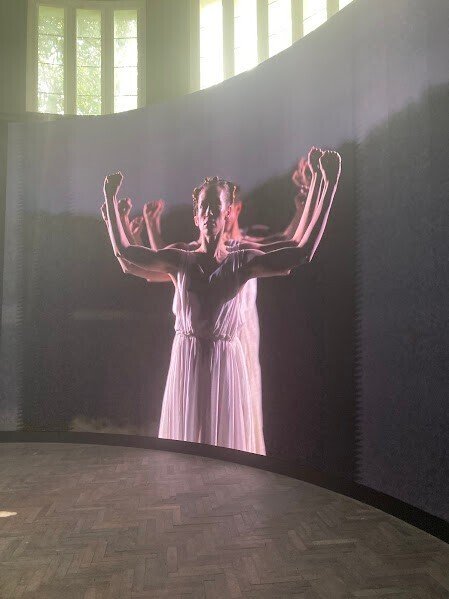
その他では、国別部門の金獅子賞を取ったオーストラリア館や、自国の少数民族文化を扱った?と思われるスカンジナビア3国館、アルセナーレ会場では、ケルト的なサウンド・インスタレーションのアイルランド館、展示室いっぱいに鉄パイプの足場を組んだ作品のイタリア館、クィア感があるスイス館と米国館が印象に残りました。——エジプト館は映像作品ですが、評判も良いし、英語字幕が読める方ならば、おススメだと思います。
全体を通して言うと、自国の先住民族や少数民族、植民地主義の歴史、あるいはジェンダーなどを含む様々なマイノリティをテーマとする展示が多かったような印象を持ちました。ジャルディーニ会場の中央パビリオンとアルセナーレ会場の前半部分で展示しているテーマ企画のキュレーションを担当したアドリアーノ・ペドロサが掲げた「どこでも外国人」——どこにでもいる外国人=誰もが外国人と拡大解釈しました——というタイトルに各国パビリオンが図らずもシンクロしたとも言えそうです。なお、帰国してしばらくニコラ・ブリオーの『ラディカント』を読んで気がついたのですが、今回のペドロサのキュレーションはブリオーがこの著作でテーマにした「クレオール化」という切り口も感じる展示でした。
Other exhibits include the Australia Pavilion, which won the Golden Lion in the country category, the Nordic Countries Pavilion, which seems to have dealt with the ethnic minority cultures of their countries, and the Ireland Pavilion, which has a Celtic-style sound installation at the Arsenal venue, I was impressed by the Italian pavilion, with its steel pipe scaffolding, which fills the exhibition room and the queer-feeling Switzerland pavilion and United States of America pavilion.
The Egyptian Pavilion is a video work, but it has a good reputation, and if you can read English subtitles, I would recommend it.
Overall, I had the impression that there were many exhibits with themes of various minorities, including indigenous peoples, ethnic minorities, the history of colonialism, and gender.
Adriano Pedrosa was responsible for the curation of the themed projects exhibited in the central pavilion of the Giardini venue and the first half of the Arsenale venue.
His slogan, ”Foreigners Everywhere'' can be broadly interpreted as “Everyone is a foreigner.'' It can be said that the pavilions of each country were inadvertently synchronized with this title.
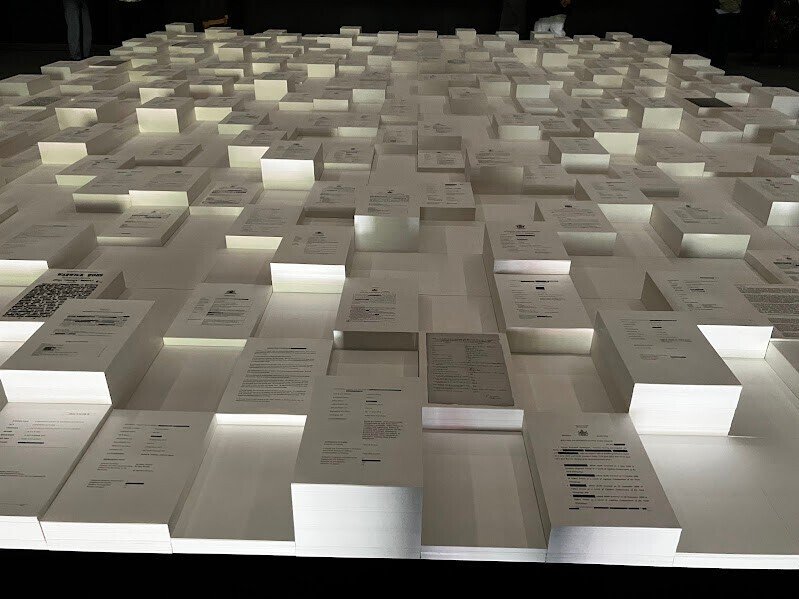
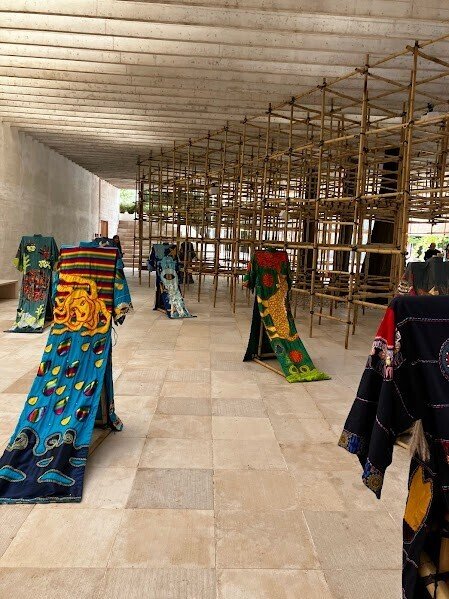


Italy館、鉄パイプのジャングルの中心に波打つ池?

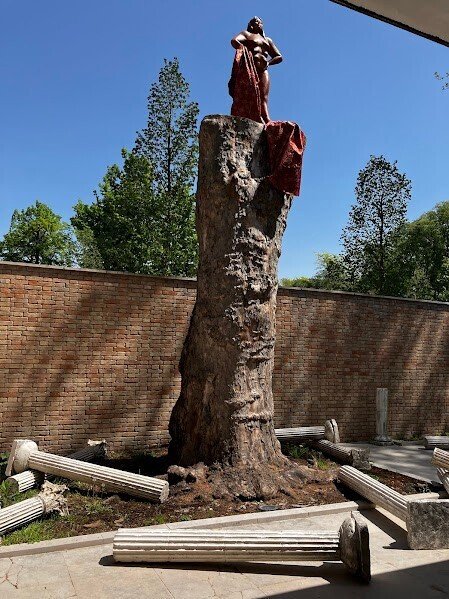
Switzerland館のホログラム的映像。実際にはスムーズな映像になっています。

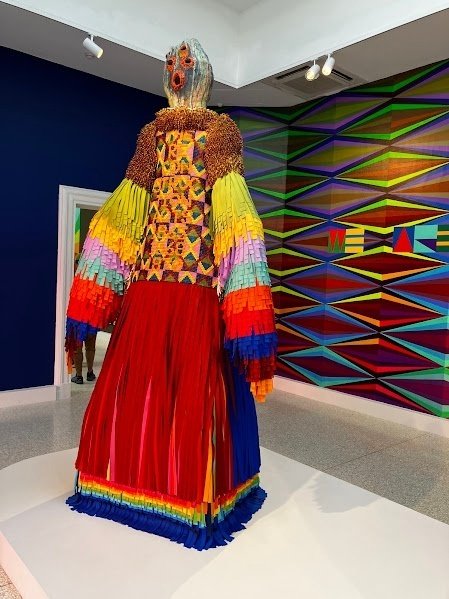

■ ポイント③ ジャルディーニとアルセナール以外では台湾館とピエール・ユイグの個展の2つが、特におススメ!
ヴェネチア市内に点在している会場は数が多く、到底全部見切れないのですが、特におススメなのが台湾館です。ここは、サン・マルコ寺院の横にあります。あいちトリエンナーレ2019の出品作家でもあった袁廣鳴(Yuan Goang-Ming)の『日常戦争』というタイトルの個展です。代表作《日常演習》のほか6点の映像インスタレーション等があり十分堪能できました。
それと、ビエンナーレとは直接関連がない展示ですが、ピエール・ユイグの『Liminal』は必見です。これはカナル・グランデをアカデミア橋経由で渡った(サン・マルコ広場から徒歩約15分)プンタ・デッラ・ドガーナという施設で、同じく11月24日まで展示されています。合計8つの展示空間でたっぷりユイグの世界に没入できます。
■ Point ③: Other than the Giardini and Arsenal, the Taiwan Pavilion and Pierre Huyghe's solo exhibition are two particularly recommended!
There are so many venues scattered throughout Venice that it's impossible to see them all, but we especially recommend the Taiwan Pavilion.
This is a solo exhibition titled "Everyday War'' by Yuan Goang-Ming, who was also an exhibiting artist at Aichi Triennale 2019.
In addition to his masterpiece “Everyday Maneuver'', there were 6 video installations, etc., which I thoroughly enjoyed.
Also, although it is not directly related to the Biennale, Pierre Huyghe's “Liminal'' is a must-see. This is a facility called Punta della Dogana, which is located across the Grand Canal via the Ponte dell'Accademia, and is also on display until November 24th. You can fully immerse yourself in Huyghe's world in a total of eight exhibition spaces.


■ ポイント④ 映像作品は意外に少ないのでザーッと見られる!
ストーリーやセリフのある映像作品は英語が読めない者にとっては非常にハードルが高いですが、今回のビエンナーレでは映像作品はエジプト館、オランダ館の一部ぐらいで助かりました。また、ジャルディーニ会場の中央パビリオンとアルセナーレ会場の前半はキュレータのアドリアーノ・ペドロサが組んだ展示です(アルセナーレ会場の後半は各国パビリオン)が、作品点数は非常に多い一方、映像作品は少なくザーッと見られます。
正直に言うと、知らない作家が殆どでした。その中で、フリーダ・カーロ、ディエゴ・リベラ、インカ・ショニバレCBE、Superflex、ヴィフレド・ラムといった知った名前に出合うことで、キュレータのペドロサの企画趣旨が推察できます。なお、マリア・タニグチ、トミエ・オオタケ、カズヤ・サカイ、ディーン・サメシマといった日系あるいは日系の血脈があると思われる美術家については、全く知りませんでした。
また、多くの展示の中には日本でいうアウトサイダーアート的な作品もありました。そうした今回の展示を見て、西洋美術の系譜から出た現代アートという文脈がそれだけグローバル化したというふうにも言える訳ですが、ペドロサのキュレーションは、そのことを逆照射しようとしているのかなと理解しました。
■ Point ④: There are surprisingly few video works, so you can take a quick look!
Video works with stories and dialogues are very difficult for people who cannot read English. However, for this Biennale, the video works were only available in the Egyptian pavilion and part of the Netherlands pavilion.
Also, the central pavilion at the Giardini venue and the first half of the Arsenale venue are exhibitions put together by Adriano Pedrosa, but while there are a large number of works, there are only a few video works, so you can take a quick look.
To be honest, I didn't know most of the artists. By encountering familiar names such as Frida Kahlo, Diego Rivera, Yinka Shonibare CBE, Superflex, and Wifredo Lam, I can infer the purpose of curator Pedrosa's project.
Furthermore, I had no knowledge of writers of Japanese ancestry or of Japanese ancestry, such as Maria Taniguchi, Tomie Otake, Kazuya Sakai, and Dean Sameshima.
Also, among the many exhibits were works that resemble what would be called outsider art in Japan. Looking at this exhibition, I can say that the context of contemporary art, which stems from the lineage of Western art, has become globalized. I realized that Pedrosa's curation was trying to reverse that direction.

(右の吊り下げられている作品はIone Saldanha(Brazil))

Berlusconi首相とQaddafi大佐が出てくる。恐らく政治的なテーマ。

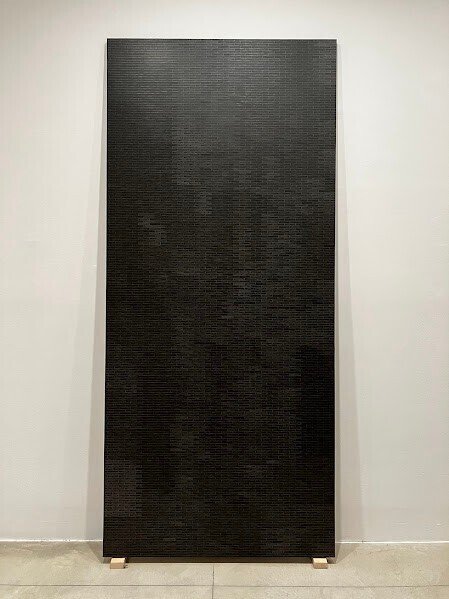
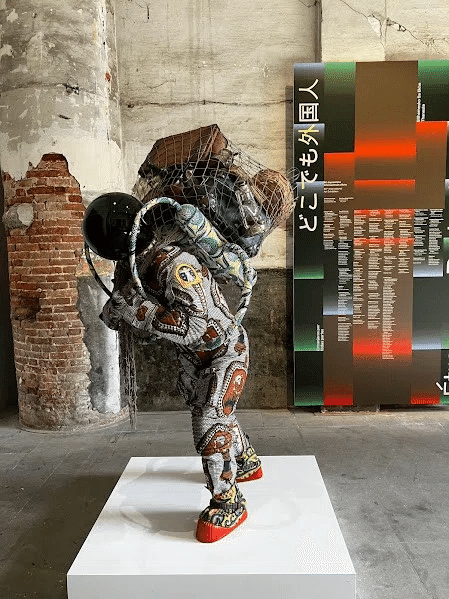
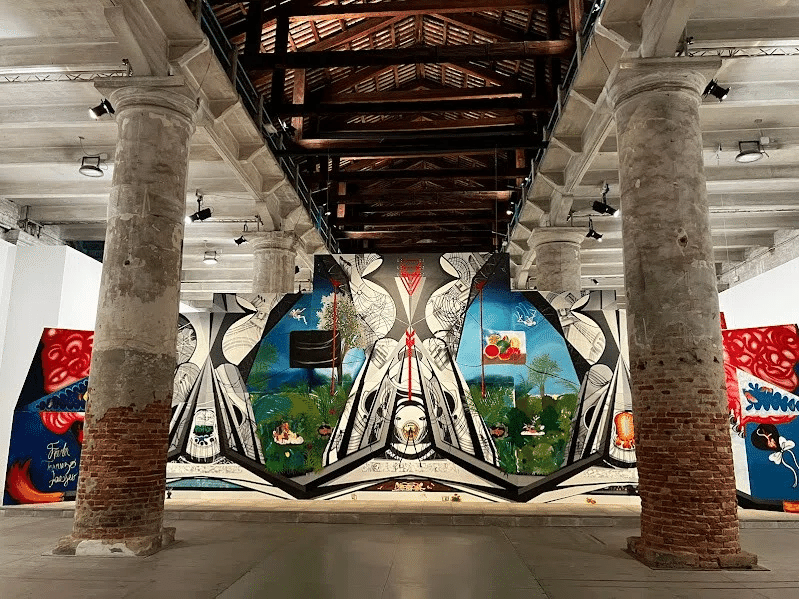
■ ポイント⑤(反省点、心残り) 動画撮影をしよう! バチカン(The Holy See)館やドイツ館の別会場も行けたら行こう!
どうしても丸2日間の鑑賞日程では、走り抜ける感じになってしまいます。ですので、さっさと撮影して見てまわって、帰国してから公式サイトなどをGoogle翻訳して理解する方が見逃しが少なくて済みそうです。そう言う私もハンガリー館(ジャルディーニ会場)と中国館(アルセナーレ会場)を見逃してしまいました。また、主要2会場以外にある国別パビリオンをザっとでも見ようとすれば、丸5日間ぐらいはかかると思います。ですので、主要2会場以外については、評判を参考にして幾つかを見る以外に方法はなさそうです。
私は行けなかったのですが、なんといっても話題のバチカン(The Holy See)館は日本を発つ前早めに予約して行った方がいいと思います(ジャルディーニ会場から水上バスでGiudecca島)。また、評判の良いドイツ館は離れ小島のLa Certosa島に第2展示場所があり、こちらも時間的に行けそうな場合は行ったほうが良いと思います。
ちなみに、日本での先入観で動画撮影は忘れてましたが、全ての作品について動画撮影は多分?可能だと思いますので、動画撮影もおススメです。
■ Point ⑤ (Reflections, regrets) Let's shoot a video! If you can go to the other venues of the Holy See Pavilion and the German Pavilion, go!
With a two-day viewing schedule, it can feel like a rush. Therefore, it would be better to quickly take pictures and look around, and then use Google Translate to understand the official website etc. after returning to Japan, so that you won't miss anything.
Having said that, I also missed the Hungarian pavilion (Giardini venue) and the China pavilion (Arsenal venue).
Also, if you want to take a quick look at the country pavilions outside of the two main venues, I think it will take about five days.
Therefore, there seems to be no other option than to look at some of the venues other than the two main ones, based on their reputation.
I wasn't able to go, but I think it's best to make a reservation early before leaving Japan to visit the Holy See Pavilion, which is a hot topic (take the water bus from the Giardini venue).
In addition, the German Pavilion, which has a good reputation, has a second exhibition location on Isola della Certosa, which I think is a good idea to visit if you have time.
By the way, I forgot to take video because of my preconceptions about Japan, but I think it is possible to take video of all the works, so I recommend taking video.


■ 結論的には、最低でも丸3日間は絶対必要です—―3日券があるのも道理です。とにかくどんどん撮影してサッササッサと見進めるのが良いと思いました。
お昼ごはんは、ジャルディーニ会場にも、アルセナーレ会場にもレストランや軽食カフェがあるので、そこで済ませる方が時間の節約になります。トイレは無料(ジェンダーフリートイレです)、既設のほか仮設トイレがありますが、混むので早め早めに用を足すことをおススメします—―ジャルディーニ会場では、会場一番東の奥の仮設トイレが比較的すいていました。
■ 各国パビリオンなどの展示の詳細は拙老のX(Twitter)https://twitter.com/forimalistをご参照ください。
■ In conclusion, at least three full days are absolutely necessary.
It makes sense to have a 3-day ticket. Anyway, I thought it would be a good idea to take lots of pictures and look at them quickly.
For lunch, there are restaurants and snack cafes at both the Giardini and Arsenal venues, so it will save you time to have lunch there.
The restrooms are free, and there are existing and temporary restrooms, but it gets crowded so we recommend you go early. At the Giardini venue, the temporary toilets at the far east end of the venue were relatively empty.
■ For details on the exhibitions , please refer to My X (Twitter) https://twitter.com/forimalist.
【参考:日本語で読める今回のヴェネチア・ビエンナーレの記事】
